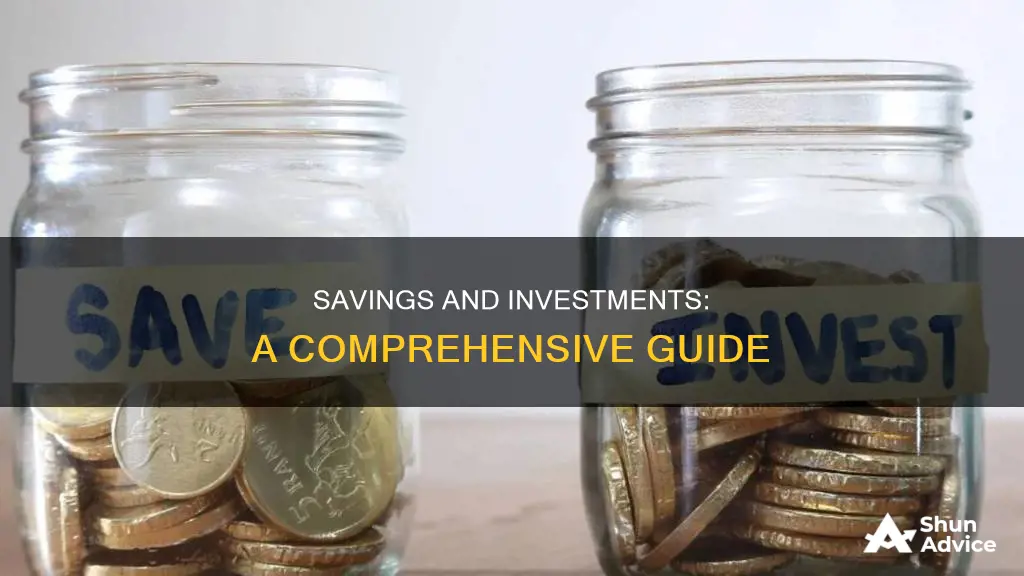
Saving and investing are two different things. Saving means putting away money for later use in a secure place, such as a bank account. Investing means taking some risk and buying assets that will ideally increase in value and provide more money than was put in, over the long term. Saving offers a guaranteed return, that is, interest on your balance, while investing includes the potential to lose money.
There are several types of savings accounts, including high-yield savings accounts, certificates of deposit (CDs), money market funds, money market deposit accounts, and treasury bills and notes.
There are also several types of investments, including stocks, bonds, mutual funds, exchange-traded funds (ETFs), and real estate.
When deciding whether to save or invest, it's important to consider your financial goals and time horizon. If you don't have an emergency fund or will need the cash in the near future, it's generally better to save. If you have a topped-up emergency fund and are saving for long-term goals, investing may be a good option.
It's also important to understand the risks and potential returns associated with different types of savings and investment accounts.
| Characteristics | Values |
|---|---|
| Best places to put your savings | High-yield savings accounts, certificates of deposit (CDs), money market funds, money market deposit accounts, treasury bills and notes |
| Best investments in 2024 | High-yield savings accounts, long-term certificates of deposit, long-term corporate bond funds, dividend stock funds, value stock funds, small-cap stock funds, real estate investment trusts (REITs), S&P 500 index funds, Nasdaq-100 index funds, rental housing |
| Saving vs. investing | Saving is for emergency funds, short-term goals, and when you need the cash within five years; investing is for long-term goals and when you don't need the cash for at least five years |
| Picking a good savings account | Look for FDIC insurance, a high annual percentage yield (APY), and no monthly fee |
| Picking a good brokerage account | Consider a robo-advisor if you want a hands-off approach, or a traditional brokerage with low fees and access to low-cost index funds |
| Investment options | Stocks, bonds, mutual funds, exchange-traded funds (ETFs) |
What You'll Learn

High-yield savings accounts
When choosing a high-yield savings account, it is important to compare APYs and fees. While APY is the primary reason for choosing a high-yield savings account, some banks also charge monthly fees, so it is important to find an account that offers a high rate without excessive fees. It is also worth considering the minimum deposit and balance requirements, as well as the ease of accessing your money.
Some popular options for high-yield savings accounts include:
- UFB Direct High Yield Savings: Offers an excellent APY of 5.25% with no monthly fee, no minimum balance requirements, and 24/7 customer support.
- Laurel Road High Yield Savings: Provides a competitive APY of 5.15% with no monthly fees or balance requirements.
- LendingClub Bank High-Yield Savings: Offers a strong APY of 5.00% with no monthly fees and a minimum deposit of $100.
- Bask Bank Interest Savings Account: Earn an APY of 5.10% with no monthly fees, minimum balance, or deposit requirements.
- TAB Bank High Yield Savings: Earn an APY of 5.27%, the highest on this list. There is no minimum deposit required, but there are other fees for things like outgoing wires and overdrafts.
Investing My Daughter's Savings: Strategies for Long-Term Growth
You may want to see also

Emergency savings accounts
Emergency savings are best kept in an easy-access account so that you can withdraw your money quickly and easily in a crisis. Some easy-access accounts offer a plastic card that can be used to withdraw money from cash machines, some offer over-the-counter withdrawals, and many allow you to transfer money out of your account online, without penalty.
However, it's worth remembering that some easy-access accounts offer more immediate withdrawals than others. If you're with an online-only bank or are operating your account by phone, it's possible that any withdrawals or transfers you make might take a few days to go through.
Easy-access accounts may also limit the number of withdrawals you can make each year without losing interest, so remember to check. Although many offer an introductory 'bonus' interest rate that might be fixed for 12 months, these accounts are typically variable-rate deals. This means that, after any introductory bonus expires, the rate payable on your cash may drop.
It's important to keep a close eye on the return your savings are earning, and switch to a new Best Rate savings account if necessary.
If you're just starting out on your savings journey, a regular savings account or 'regular saver' might be ideal. These require customers to deposit money each month without fail, and drip-feed cash into their account in a disciplined way. The interest rate on offer can be fixed or variable.
These accounts typically last for one year and restrict you from investing more than a certain sum (e.g. a maximum of £250 per month), preventing you from placing extra cash in your account as and when it suits you.
Savings or Investing: Where Should Your Money Go?
You may want to see also

Investment costs
Fees and Commissions
Whether you're investing in stocks, bonds, mutual funds, or retirement plans like 401(k)s, it's common to encounter fees and commissions. These charges vary depending on the type of investment and the institution offering them. For example, your employer may subsidize some or all of the costs of a 401(k), while a financial advisor or broker may charge fees for their services. It's important to understand the fee structure before committing to any investment.
Taxes
Taxes can significantly impact your investment returns. Different types of investments are taxed differently. For instance, interest earned on savings accounts is usually taxable, while investments like stocks and bonds may be subject to capital gains tax when you sell them for a profit. Additionally, some investments, such as government bonds or certain retirement accounts, offer tax advantages, so it's essential to consider the tax implications when making investment decisions.
Account Maintenance Fees
Some investment accounts, such as brokerage accounts or retirement plans, may charge annual or maintenance fees. These fees are typically separate from any transaction fees and are levied for the ongoing management and administration of your account. While these fees can vary widely, it's important to factor them into your overall investment costs.
Transaction Costs
Every time you buy or sell an investment, there may be associated transaction costs. These could include brokerage fees, trading commissions, or other charges. For example, if you invest in stocks, you'll typically pay a commission to a broker for executing the trade. Similarly, mutual funds may have sales loads or redemption fees. It's important to be mindful of these costs, as they can eat into your investment returns over time.
Opportunity Cost
When you commit your money to a particular investment, you're forgoing other potential uses of that money. This is known as opportunity cost. For example, if you invest in a long-term certificate of deposit (CD) that locks in your funds for several years, you're giving up the opportunity to use that money for other investments or expenses during that period. Understanding the opportunity cost of your investments can help you make more informed decisions about allocating your funds.
Management Fees for Managed Funds
If you invest in managed funds, such as mutual funds or exchange-traded funds (ETFs), there will typically be ongoing management fees. These fees cover the costs of the fund manager's time and expertise in selecting and monitoring the investments within the fund. Management fees are usually expressed as an annual percentage of the assets you have invested in the fund and can vary widely depending on the type of fund and the investment firm.
In conclusion, understanding investment costs is crucial for making informed financial decisions. By considering fees, commissions, taxes, and other associated costs, you can better evaluate the potential returns on your investments and make choices that align with your financial goals and risk tolerance.
How to Allocate Your Money: Rent, Savings, Investments, and Utilities
You may want to see also

Savings products
High-Yield Savings Accounts:
High-yield savings accounts are offered by many banks and online institutions, providing higher interest rates than standard savings accounts. They are FDIC-insured and can be a good option for those seeking higher returns while maintaining a low-risk profile. These accounts may require larger initial deposits and have limited access.
Certificates of Deposit (CDs):
CDs are available through banks and credit unions, offering higher interest rates than savings accounts. They require you to keep your money in the account for a specified period, with penalties for early withdrawal. Popular maturity periods include six months, one year, and five years. CDs are FDIC-insured and provide a relatively safe investment option.
Money Market Funds:
Money market mutual funds invest in low-risk securities and are offered by mutual funds, brokerage firms, and banks. While they provide similar returns to short-term interest rates, the interest rates are not guaranteed, so research is essential. Money market funds are not FDIC-insured but are regulated by the SEC.
Money Market Deposit Accounts:
Offered by banks, these accounts typically require a minimum initial deposit and balance, with limited monthly transactions. They offer FDIC insurance and lower interest rates than CDs but provide easier access to cash. Penalties may apply if the minimum balance is not maintained.
Treasury Bills and Notes:
U.S. government treasury bills and notes are backed by the full faith and credit of the government and are exempt from state and local taxes. They are sold at a discount and provide interest upon maturity. Treasury notes have fixed interest rates and can be cashed in for face value at maturity if purchased at a discount. They are available for a minimum purchase of $100.
Bonds:
Bonds are low-risk debt investments issued by companies, municipalities, states, and governments. When you purchase a bond, you lend money to the entity, which pays interest over the life of the bond and returns the face value upon maturity. Bonds have varying degrees of risk, returns, and maturity periods, and early withdrawal may result in penalties.
These savings products offer a range of options for individuals looking to grow their wealth. It is important to consider factors such as risk tolerance, time horizon, financial situation, and investment goals when choosing the right savings products for your needs.
Saving and Investing: Strategies for Future Financial Goals
You may want to see also

Investment funds
There are several types of investment funds, including mutual funds, exchange-traded funds (ETFs), and hedge funds. Each type of fund has its own unique characteristics and risk profile, so it's important to understand the differences before investing.
Mutual funds are one of the most common types of investment funds. They are typically actively managed by professional fund managers who aim to beat the market and provide strong returns for investors. Mutual funds can invest in a wide range of assets, including stocks, bonds, and other securities. They are also relatively liquid, meaning investors can usually redeem their shares at any time. However, mutual funds often have higher fees than other types of investment funds due to the active management involved.
ETFs have become increasingly popular in recent years. They are similar to mutual funds in that they hold a basket of different securities, but they trade on an exchange like a stock. ETFs are often passively managed, tracking a particular stock market index or sector. They tend to have lower fees than mutual funds and are more tax-efficient. However, they may not offer the same level of active management and potential for market-beating returns as mutual funds.
Hedge funds are investment funds that cater to high-net-worth individuals and institutions. They employ a wide range of investment strategies, including long/short equity, event-driven, and relative value arbitrage, among others. Hedge funds often use leverage and complex derivatives to amplify returns and are generally considered riskier than mutual funds or ETFs. They also typically have much higher fees and require investors to lock up their money for extended periods.
When investing in any type of investment fund, it's important to carefully consider your risk tolerance, investment goals, and time horizon. Different funds will have different risk profiles, so it's crucial to understand the potential downsides as well as the potential upsides of each investment. Diversification across asset classes and investment strategies can help to reduce risk and improve long-term returns.
Kroger Savings Club: A Smart Investment Strategy
You may want to see also
Frequently asked questions
Savings accounts that have FDIC insurance, a high annual percentage yield (APY), and no monthly fee are the best. Online banks tend to offer higher interest rates than traditional banks.
It is recommended to save enough to cover three to six months' worth of living expenses.
The best investments depend on your risk tolerance, time horizon, knowledge of investing, and financial situation. Some examples of good investments include high-yield savings accounts, long-term certificates of deposit (CDs), dividend stock funds, and S&P 500 index funds.
When picking a brokerage account, consider how hands-on you want to be. Robo-advisors are a good option for beginners as they offer diversification, low costs, and rebalancing. Traditional brokerages can also be a good option if you find one with zero fees and low-cost index funds.







